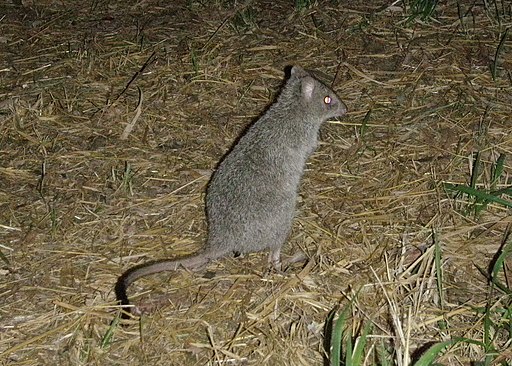Superregnum: Eukaryota
Cladus: Unikonta
Cladus: Opisthokonta
Cladus: Holozoa
Regnum: Animalia
Subregnum: Eumetazoa
Cladus: Bilateria
Cladus: Nephrozoa
Superphylum: Deuterostomia
Phylum: Chordata
Subphylum: Vertebrata
Infraphylum: Gnathostomata
Megaclassis: Osteichthyes
Cladus: Sarcopterygii
Cladus: Rhipidistia
Cladus: Tetrapodomorpha
Cladus: Eotetrapodiformes
Cladus: Elpistostegalia
Superclassis: Tetrapoda
Cladus: Reptiliomorpha
Cladus: Amniota
Cladus: Synapsida
Cladus: Eupelycosauria
Cladus: Sphenacodontia
Cladus: Sphenacodontoidea
Cladus: Therapsida
Cladus: Theriodontia
Subordo: Cynodontia
Infraordo: Eucynodontia
Cladus: Probainognathia
Cladus: Prozostrodontia
Cladus: Mammaliaformes
Classis: Mammalia
Subclassis: Trechnotheria
Infraclassis: Zatheria
Supercohors: Theria
Cohort: Metatheria
Cohors: Marsupialia
Cladus: Australidelphia
Cladus: Eomarsupialia
Ordo: Diprotodontia
Subordo: Macropodiformes
Familia: Potoroidae
Genus: Bettongia
Species: Bettongia tropica
Name
Bettongia tropica Wakefield, 1967
Type locality: Australia, Queensland, Mt. Spurgeon
Vernacular names
References
Bettongia tropica in Mammal Species of the World.
Wilson, Don E. & Reeder, DeeAnn M. (Editors) 2005. Mammal Species of the World – A Taxonomic and Geographic Reference. Third edition. ISBN 0-8018-8221-4.
Victorian Nat. 84: 15.
Wilson, D.E. & Reeder, D.M. (eds.) 2005. Mammal Species of the World: a taxonomic and geographic reference. 3rd edition. The Johns Hopkins University Press: Baltimore. 2 volumes. 2142 pp. ISBN 978-0-8018-8221-0. Reference page.
The northern bettong (Bettongia tropica) is a small, endangered, gerbil-like mammal native to forests in northeast Australia. A member of the rat-kangaroo family (Potoroidae), it moves by hopping and lives in burrows, feeding at night on roots and fungi. It is also a marsupial and carries its young in a pouch. The northern bettong is threatened by habitat loss, and is now restricted to a few small areas.
Contents
1 Habitat
2 Lifespan
3 Behavior
4 Threats
5 References
6 External links
Habitat
The northern bettong is restricted to some areas of mixed open Eucalyptus woodlands and Allocasuarina forests bordering rainforests in far northeastern Queensland, Australia.
Lifespan
The typical bettong lives in the wild for about 4 to 6 years. This is a very short life span, but according to the Smithsonian's National Zoologist, they can, under proper care, live up to the age of 15 years.[5]
Behavior
All species of the bettong are nocturnal. They carry nesting materials with their long tails and can be found in underground burrows that they escape to during the day. They like to feed at night and their range of food varies. They rarely drink water, and refrain from eating any green plants. They primarily seek fungus and plants such as mushrooms, tubers, scrubs, fruits and seeds. They use their front claws to dig for tubers, identifying them via their sense of smell.[5] These animals are able to reproduce at any time of the year, and can produce three young in a favorable year. This high rate of reproduction can lead to fluctuations in population growth.[6]
It spends the day in a well concealed nest constructed beneath a tree, within a clump of grass or in other litter collected at ground level. Nesting material is carried using its prehensile tail. Ectomycorrhizal fungal sporocarps are the staple diet of the northern bettong. These are dug from beneath the soil at the bases of trees, and work to date suggests substantial nightly movements are often required to detect this irregularly-distributed food source. Other foods in the diet include grass roots and tubers, lilies, herbs, and sedges. The northern bettong appears to breed all year round, and like other relatives of the kangaroos, the joey is carried in a pouch until it is old enough to follow the mother as a 'young-at-foot'.
Threats
The northern bettong is listed as a threatened species. It is estimated that there are only 1000 left in the wild with only two known populations in the Mareeba region of the Atherton Tablelands (Davies Creek, Emu Creek and Tinaroo Creek).[7] The most significant threat to the northern bettong is habitat loss caused by land clearing for agriculture.[6]
A Recovery Team including government agencies, scientists, Traditional Owners and volunteer groups are focusing conservation efforts are focusing on improving habitat.
References
Groves, C. P. (2005). Wilson, D. E.; Reeder, D. M. (eds.). Mammal Species of the World: A Taxonomic and Geographic Reference (3rd ed.). Baltimore: Johns Hopkins University Press. pp. 57–58. ISBN 0-801-88221-4. OCLC 62265494.
Burnett, S. & Winter, J. (2008). "Bettongia tropica". IUCN Red List of Threatened Species. 2008. Retrieved 29 December 2008. Database entry includes justification for why this species is listed as endangered
"Appendices | CITES". cites.org. Retrieved 2022-01-14.
Wakefield, N.A. (1967). "Some taxonomie revision in the Australian marsupial genus Bettongia (Macropodidae), with description of a new species". The Victorian Naturalist. 84: 8–22.
"Brush-tailed bettong". Smithsonian's National Zoo. Retrieved 2018-04-28.
"Bettongs (Rat Kangaroos) - Bush Heritage Australia". Bush Heritage Australia. Retrieved 2018-04-28.
Whitehead, Tegan Carla (2018). Population trends, habitat requirements and conservation recommendations for an endangered marsupial, the northern bettong (Bettongia tropica) (phd thesis). James Cook University. doi:10.25903/5d0ab9e4fe2eb.
Retrieved from "http://en.wikipedia.org/"
All text is available under the terms of the GNU Free Documentation License


